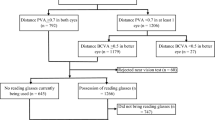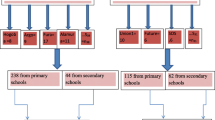Abstract
Uncorrected presbyopia is a major cause of poor near vision in the developing countries. To determine the prevalence and demographic characteristics of presbyopia among adult populations (40 years and above) in a sub-urban population, southwest Nigeria, a population-based cross-sectional study was carried out from April to May 2014. A multi-stage sampling method was used to select eligible respondents. All participants had distance visual acuity assessment done and participants with visual acuity of less than 6/6 were refracted. Near vision was then assessed at 40 cm with distance correction in place if required. Information on near vision was obtained from the participants using interviewer administered questionnaires. Data collected were analysed using SPSS version 22. A total of 440 subjects aged 40 years and above were studied. Prevalence of presbyopia was 75 % and was significantly associated with increasing age. There was higher prevalence of presbyopia among females than males (76.3 % vs. 73.5 %), though not statistically significant. Also prevalence of presbyopia was not significantly associated with educational and occupational status in the study. This study demonstrated a high prevalence of presbyopia. There is need for improved awareness on presbyopia screening and available correction in the local government.

Similar content being viewed by others
References
Beers APA, Van der Heijde GL (1996) Age-related changes in the accommodation mechanism. Optom Vis Sci 73:235–242
Holden BA, Fricke TR, Ho S et al (2008) Global vision impairment due to uncorrected presbyopia. Arch Ophthalmol 126:1731–1739
Patel I, Munoz B, Burke AG et al (2006) Impact of presbyopia on quality of life in a rural African setting. Ophthalmology 113:728–734
Bekibele CO, Gureje O (2008) Impact of self-reported visual impairment on quality of life in the Ibadan study of ageing. Br J Ophthalmol 92:612–615
Chiroma R (2008) Prevalence of presbyopia and the impact of uncorrected presbyopia on the quality of life in rural Gwagwalada, Abuja Nigeria. Msc Dissertation submitted to London School of Hygiene and Tropical Medicine
Lu Q, He W, Murthy GVS et al (2011) Presbyopia and near-vision impairment in rural northern China. Investig Ophthalmol Vis Sci 52:2300–2305
Burke AG, Patel I, Munoz B et al (2006) Population-based study of presbyopia in rural Tanzania. Ophthalmology 113:723–727
Nirmalan PK, Krishnaiah S, Shamanna BR, Rao GN, Thomas R (2006) A population-based assessment of presbyopia in the state of Andhra Pradesh, south India: the Andhra Pradesh Eye Disease Study. Investig Ophthalmol Vis Sci 47:2324–2328
Duarte WR, AsJD Barros, Dias-da-Costa JS, Cattan JM (2003) Prevalence of near vision deficiency and related factors: a population-based study in Brazil. Cad de Saude Publica 19:551–559
Maseko S (2011) Prevalence of Presbyopia, Near Spectacle Correction Coverage and Patients’ Acceptance of Ready Made Spectacles in Swaziland. Msc Dissertation submitted to London School of Hygiene and Tropical Medicine
Laviers H (2007) The prevalence of presbyopia and the feasibility of community distribution of near spectacles in adults in Zanzibar, East Africa. J Community Eye Health 20:73
Nwosu SN (1997) Ametropia in Onitsha, Nigeria. Niger J Ophthalmol 5:21–24
Bagaiya T, Pam V (2004) Refractive errors in Kaduna, Nigeria. Niger J Surg Res 5:106–109
Adegbehingbe BO, Majekodunmi AA, Akinsola FB, Soetan EO (2004) Pattern of refractive errors at Obafemi Awolowo University Teaching Hospital, Ile-Ife, Nigeria. Niger J Ophthalmol 11:76–79
Odugbo OP, Wade PD, Velle LD, Kyari F (2012) Prevalence of presbyopia, refractive errors and usage of spectacles among commercial intercity vehicle drivers in Jos, Nigeria. Jos J Med 6:37–41
Bekibele CO, Fawole OI, Bamgboye AE, Adekunle LV, Ajayi R, Baiyeroju AM (2007) Prevalence of refractive error and attitude to spectacle use among drivers of public institutions in Ibadan, Nigeria. Ann Afr Med 6:26
Forrester JV (1997) Aging and vision. Br J Ophthalmol 81:809–810
Duane A (1908) An attempt to the determine the normal range of accommodation at various ages, being a revision of Donder’s experiments. Trans Am Ophthalmol Sci 11:634–641
Thakur RP, Banerjee A, Nikumb VB (2013) Health problems among the elderly: a cross-sectional study. Ann Med Health Sci Res 3:19–25
Adegbehingbe BO, Soetan EO (2006) Risk factors for early presbyopia in Nigerians. Niger J Surg Sci 16:7–11
Manuel M (1979) The geographical factors in the onset of presbyopia. Trans Am Ophalmolol Sci 77:603–621
Weale RA (2003) Epidemiology of refractive errors and presbyopia. Surv Ophthalmol 48:515–543
Kish L (1995) Survey sampling. John Wiley and Sons, New York
Ogunniyi A, Osuntokun BO (1993) Determination of ages of elderly Nigerians through historical events: validation of Ajayi-Igun 1963 listing. West Afr J Med 12:189–190
Olarn Anne (2012) Population based assessment of presbyopia prevalence, near-vision spectacle coverage and barriers to spectacle use in Burias Island, Masbate, Philippines. MSc dissertation submitted to London School of Hygiene and Tropical Medicine
Hickenbotham A, Tiruveedhula P, Roorda A (2012) Comparison of spherical aberration and small pupil profiles in improving depth of focus for presbyopic corrections. J Cataract Refract Surg 38:2071–2079
Nwosu SN (1998) Ocular problems of young adults in rural Nigeria. Int Ophthalmol 22:259–263
Hickenbotham A, Roorda A, Steinmaus C, Glasser A (2012) Meta-analysis of sex differences in presbyopia. Invest Ophthalmol Vis Sci 53:3215–3220
McDonnell PJ, Lee P, Spritzer K, Lindblad AS, Hays RD (2003) Associations of presbyopia with vision-targeted health-related quality of life. Arch Ophthalmol 121:1577–1581
Author information
Authors and Affiliations
Corresponding author
Ethics declarations
Conflict of Interest
No conflicting relationship exists for any author.
Rights and permissions
About this article
Cite this article
Seidu, M.A., Bekibele, C.O. & Ayorinde, O.O. Prevalence of presbyopia in a semi-urban population of southwest, Nigeria: a community-based survey. Int Ophthalmol 36, 767–773 (2016). https://doi.org/10.1007/s10792-016-0198-3
Received:
Accepted:
Published:
Issue Date:
DOI: https://doi.org/10.1007/s10792-016-0198-3




